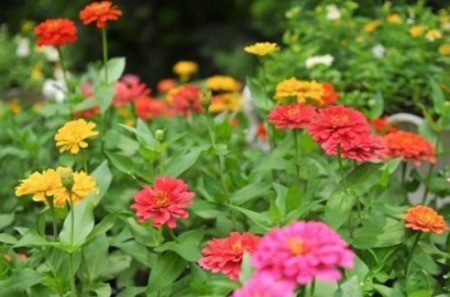
Few annuals look as cheerful and appealing in the garden as Zinnia flowers. They come in a wide range of sizes and forms; from single-stemmed upright, cut-flower types to multi-stemmed, multi-flowered border plants. Zinnias' daisy-like flowers may be single, semi-double, or double (the largest are nearly 6 inches across) and come in nearly every shade of the rainbow but blue.
Bloom time: Summer through early fall.
Flower color: Varies by species; a wide range of pinks, reds, oranges, whites, purples, green, and yellow.
Hardiness: Half-hardy annual.
Height: 4 to 48 inches.
Light preference: Full sun.
Soil preference: Nutrient-rich, well drained soil.
Spread: 10 to 24 inches.
Staking: The tall strong stems usually do not require staking.
Uses: Container planting, cut-flower garden, edging, mass planting, meadow garden, mixed border; attracting butterflies.
Planting Outdoors: Zinnias are one of the easiest annual flowers to grow. Once the weather warms up, choose a site where there's full sun and well-drained soil. Loosen the soil and plant seeds 2 to 3 inches apart, in rows spaced 12 inches apart. Cover the seeds with 1/2 inch of soil and water. In as little as 6 weeks your plants will have reached their blooming size.
Starting Indoors: Zinnia seeds can also be started indoors 4 to 5 weeks before the last frost date. Sow seeds 1/2 inch deep in individual peat pots. Most will germinate in as little as 4 to 5 days. Keep the seedlings warm (70 degrees F to 85 degrees F ) and moist and provide them with a strong light source until transplanting them outdoors. Don't be in a rush to put zinnias outside. Wait until all danger of frost has passed and the weather warms up. After hardening them off, plant the peat pots directly into the ground to avoid disturbing their roots.
Purchased Seedlings: Nurseries and garden centers often sell zinnias in cell packs. If you buy them, buy them early. Once they reach flowering size they don't transplant as well. Pinch them back by 1/3 at planting time to help reduce transplant shock.
All varieties of zinnia respond well to cutting, and the stems and flowers hold up well in water. This includes the old-fashioned variety "Cut and Come Again" (Zinnia pumila), which is named for its vigor and ability to produce blooms for months on end. Cutting fresh flowers and regular deadheading will encourage the plant to keep producing. For cut flower displays, choose buds that are just about to open and cut them early in the day. Plants that produce tall stems with few buds can be pinched back to encourage branching.
Annuals are generally less prone to problems from pests and diseases than perennials, because they don't live as long. Unfortunately, powdery mildew can be a major problem for zinnias, especially in humid conditions. Here are some tips for prevention:

About The Author: Ellen Brown is an environmental writer and photographer and the owner of Sustainable Media, an environmental media company that specializes in helping businesses and organizations promote eco-friendly products and services.
Add your voice! Click below to comment. ThriftyFun is powered by your wisdom!